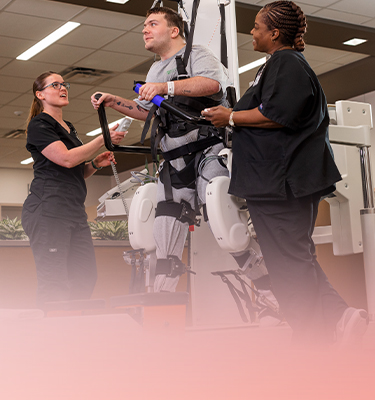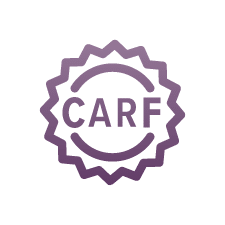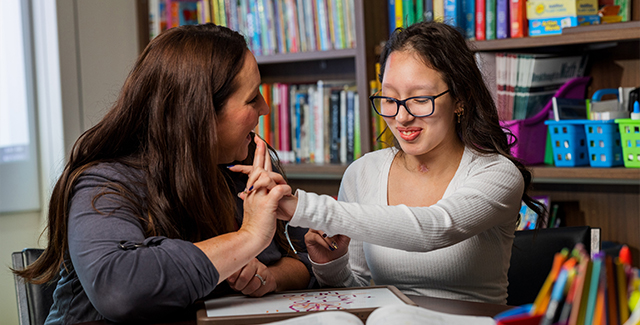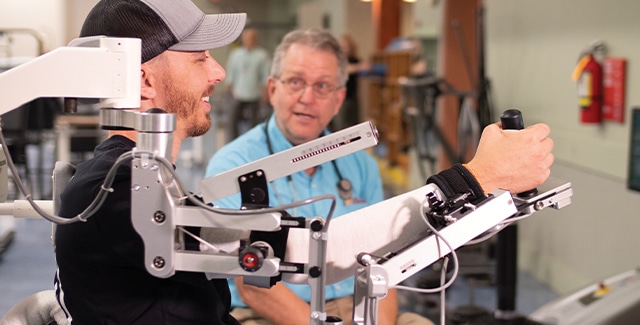BrainBrain Injury
Madonna’s certified brain injury specialists move patients of all ages toward lifelong brain health and recovery, working with those who have sustained a concussion, diffuse axonal injury, hematoma, abusive head injury, skull fracture, or other brain injury.


0
0
0
0
Brain Injury Program Overview
Madonna’s CARF-accredited brain injury program brings together an expert team of physicians, physical therapists, occupational therapists, speech-language pathologists, neuropsychologists and other clinicians to care for even the most severe brain injuries.
Family-Centered Care
We believe in the power of family support. Our brain injury program includes family education and involvement to ensure a holistic approach to recovery.
State-of-the-Art Technology and Facilities
Madonna is equipped with the latest technology and a secure unit designed to support the unique needs of brain injury survivors. Our commitment to research and continuous innovation make us a leader in brain injury rehabilitation.
A Typical Day
No two brain injuries are alike, and that’s why Madonna’s progressive treatment plans are customized for each patient. Find out what a typical day of intensive therapy could look like for a brain injury patient at Madonna.
SERVICES OFFERED
DoC Program
A component of our specialized brain injury program, Madonna’s Disorders of Consciousness (DoC) program provides rehabilitative care for patients with poor or low arousal and awareness. We care for the complex medical needs of these individuals while also providing innovative therapies to stimulate consciousness and facilitate recovery. Click here to learn more about our Disorders of Consciousness program.
Vision Rehabilitation
Madonna is the only hospital in the region to provide an extensive vision rehabilitation program delivered by specially trained experts who use state-of-the-art technology to help patients of all ages with visual impairments resulting from illness or injury to maximize their quality of life in home and community-related roles.
ThinkFirst
Madonna has been a ThinkFirst Chapter since August 2010, creating injury prevention awareness in the community. We are committed to promoting safety and our clinicians offer expertise at thousands of community events each year to reduce the risk of serious injury.
Community Reintegration
Madonna integrates a variety of community re-entry, recreational, leisure and adaptive sports and recreation opportunities into the rehabilitation process. Therapy may include off-site visits to locations that may be challenging for brain injury patients. Patients may also work on specific goals related to returning to work, school or driving during their rehabilitation stay.
Additional Resources
Madonna is committed to our patients’ lifelong success and wellness. When appropriate, we offer services, such as home modifications, assistive technology, orthotics, prosthetics and emotional support resources for patients during and after their preparation to return home.
Patient Success Stories

An Interdisciplinary team will guide the recovery process
Madonna’s care team of highly trained experts across specialties offers the best experiences and outcomes for stroke survivors and their families. This physician-led team includes skilled physical therapists, occupational therapists, speech-language pathologists, respiratory therapists, rehabilitation nurses, neuropsychologists, certified teachers and more.

Overseen by a Board-Certified Physician in Physical Medicine and Rehabilitation with a Sub-Specialty in Brain Injury
Dr. Morgan LaHolt, MD, serves as Madonna’s physician program director for the brain injury program. He earned his medical degree from the UNMC College of Medicine. After an internship in family medicine at the University of Nebraska Medical Center, he completed a physical medicine and rehabilitation residency program at the University of Missouri, serving as chief resident during his final year. He is board-certified in physical medicine and rehabilitation and the subspecialty of brain injury medicine. He is also board-certified by the American Board of Independent Medical Examiners.
Awards & accreditations
We gain recognition by acknowledging each patient’s unique needs. We are always pioneering and researching new technologies to serve specialized purposes, investing in exceptional medical talent, and developing progressive treatments to change the face of rehabilitation. Everything we do is dedicated to helping you live your most independent life.

CARF Accreditation
Madonna has received the highest possible level of accreditation from the Commission on Accreditation of Rehabilitation Facilities (CARF) across 14 inpatient/outpatient categories. This year, Madonna celebrates 45 years of continuous CARF accreditation.
Brain Injury Specialty Accreditation
Madonna has CARF-accredited brain injury inpatient and outpatient specialty programs for adults on both campuses.
Pediatric Brain Injury Accreditation
Madonna is one of only seven CARF-accredited pediatric brain injury specialty inpatient and outpatient programs in the United States.
ADDITIONAL RESOURCES
Glossary of Terms
Learn the most commonly used terms in brain injury rehabilitation.
Patient Financial Services
From understanding billing and insurance to exploring payment options and financial assistance, we ensure you have the necessary resources and guidance.
Family Housing
We provide comfortable and convenient housing options so you can stay connected and supportive throughout your loved one’s recovery journey. Explore our amenities today.
Online Resources
Dealing with a serious injury or illness can be overwhelming. Madonna has compiled a list of local and national resources to assist patients and families. Check it out here.
Scope of Services
Brain Injury Program Scope Statement 2023
The goal of Madonna’s Brain Injury Rehabilitation Program is to help the individuals we serve become as independent as possible after their injury. Madonna strives to establish a partnership for life that the patient and their family can depend on throughout their recovery and beyond. Programming is highly individualized, dependent upon each individual’s needs and personal goals. Family members are encouraged to be actively involved in therapy and nursing care so they may reinforce learning new skills.
We serve survivors of traumatic or non-traumatic brain injuries of any severity. Madonna’s continuum of care serves patients with brain injury who may be in Disorders of Consciousness (DoC) including the behavioral presentation of a vegetative state and minimally conscious state. Madonna’s brain injury program also serves those patients who are actively participating in their rehabilitation, but require inpatient services for medical stability and management. Finally, we provide rehabilitation for persons served through their last stages of rehabilitation focusing on a return to home, community, school, employment, leisure, and wellness life roles. Madonna Rehabilitation Hospital is one of the only hospitals in the region accredited by the Commission for Accreditation of Rehabilitation Facilities (CARF), as a Brain Injury Specialty Program for multiple levels of care, including acute rehabilitation and intensive outpatient services. Throughout Madonna’s continuum of care, the brain injury program specializes in recognizing, assessing and treating conditions related to brain injury and preventing complications related to brain injury. Our program also focuses on educating patients and families on prevention and reducing the risk of future brain injuries.
Madonna is one of only seven organizations in the U.S. that is accredited in both Brain Injury and Pediatric Specialty Programs. This means that Madonna meets higher standards relating to staff training, programming, patient and family education, advocacy and outcomes management.
Madonna admits patients from multiple trauma systems and acute care hospitals from the Midwestern region and nationally. In Madonna’s 2023 fiscal year, we served 1,300 individuals with brain injury across the continuum of care within our Lincoln and Omaha campuses. Outpatients are referred to our services from a variety of community physician specialties. A referral from a physician is required to access Madonna’s continuum of care.
Scope of services: Madonna’s brain injury program provides comprehensive rehabilitation services including physical, occupational, speech, respiratory, recreational and nutritional therapies, rehabilitation psychology, neuro-optometry, case management, social work services, spiritual care services and orthotics/prosthetics as needed. In addition to these specialties, rehabilitation nursing and access to a physician with training in physical medicine and rehabilitation is available 24 hours per day, seven days per week on an inpatient basis. These specialized services are available throughout our continuum of care including Long Term Acute Care, Acute Rehabilitation, and Rehabilitation Day Programs. Family members and caregivers for the persons served are provided with structured training and education on brain injury and providing care for their loved one. Education topics include deficits experienced post-brain injury, understanding the rehabilitation process, risks associated with brain injury, long-term resources, aging with brain injury, relationships after brain injury and multiple others. Family and patient preferences are solicited and used as part of the rehabilitation process. Families and caregivers are involved in developing an appropriate discharge plan. They are provided resources to help access life-long care as needed. While most of our patients with brain injury are discharged to a community setting, patients who need additional time in a more structured, residential setting after discharge are also served. Madonna also offers a variety of virtual rehabilitation and telemedicine services for those persons served who would benefit from virtual services or have transportation or geographical barriers where virtual services are required. Madonna’s Brain Injury Specialty physicians can provide telemedicine visits. Virtual home assessments are provided for persons and families served on inpatient to assess the home regardless of geographic location to provide the most applicable recommendations on home accessibility to promote discharge to home and community. Vision rehabilitation is also offered virtually by Madonna’s staff neuro-optometrists.
Fees of Service: Cost of care is determined by diagnosis, level of care, acuity of care and length of stay. For more information on fees of service please see: https://www.madonna.org/admissions
Madonna accepts patients with a wide variety of funding, including Medicare, Nebraska Medicaid, commercial insurances such as Blue Cross and Blue Shield, and worker’s compensation, and will consider out-of-state Medicaid and non-funded patients on a case-by-case basis.
Clinical Expertise: Each patient’s care is directed by a physician who specializes in physical medicine and rehabilitation and/or a physician with specialization in internal medicine. A pediatrician is involved in the daily care of individuals 18 years or younger. Several Madonna nurses have specialty training as Certified Rehabilitation Registered Nurses. Persons experiencing Disorders of Consciousness may benefit from pulmonary and respiratory services to assist with weaning from a mechanical ventilator. Madonna’s pulmonary program has excellent outcomes for successful weaning from the ventilator and tracheostomy. Patients requiring specialized services and interventions such as cardiology, pulmonology, and orthopedics are referred and provided with the appropriate medical and follow-up services.
Rehabilitation: Madonna’s dedicated team completes special competency and nationally certified training in the treatment of persons with brain injury. The team, consisting of physical, occupational, speech, recreational and respiratory therapists, as well as neuropsychology, social worker, rehabilitation nurse and case manager, work together to meet the complex physical, cognitive, social and emotional needs of persons with brain injury. On average, patients receive three hours of therapy on an acute rehabilitation level of care. Madonna’s therapy staff is also trained to provide clinical care to the most severe brain injuries experiencing Disorders of Consciousness. Madonna has a staff of rehabilitation psychologists on site who are an integral part of the rehabilitation team. They participate in team meetings, lead behavioral intervention plans and provide counseling and support for both the patient and their family members.
Days and hours of Service: Monday-Fridays. Patients receive assigned hours of therapy appropriate for their level of care and function. Nursing and physician services provided within the scope of the brain injury program are provided 24 hours a day, seven days a week on an inpatient basis. Saturday and Sunday therapies are provided on an as-needed basis for inpatient therapies. Outpatient services are provided Monday-Friday except for some holidays.
Environment: Madonna’s environment is designed and specialized for the brain injury populations. Patients with a recent brain injury may go through an agitated and restless stage in their recovery. Madonna can lock sections of the brain injury rehabilitation unit to provide a safe environment for patients as they emerge from coma and go through an increased restless and confused phase of recovery. Madonna also provides one-on-one supervision and video monitoring as needed for patient safety. Adolescents and children 18 years or younger are admitted to the Pediatric Rehabilitation Unit on the Omaha campus. These children are provided rehabilitation in a dedicated, secure area designed specifically for children and adolescents. Pediatrics are also served on an outpatient basis on both our Lincoln and Omaha campuses and have access to the Therapeutic Learning Center to facilitate successful integration into the academic environment after brain injury.
Community Re-Entry: Rehabilitation does not stop when the patient gains basic skills of self-care and mobility. Participation in community activities is also an important part of the recovery process and is integrated into therapy sessions. Recreational therapy provides a variety of adaptive sports and recreational outings to help patients and families recognize that they can still participate in enjoyable activities. Patients may also work on specific goals related to return to driving, school re-entry, or visit with a vocational rehabilitation counselor about work re-entry.
Preparing for Home: Persons served and their caregivers, are provided with a self-care training program based upon principles of self-advocacy and self-direction. Patients, with or without their caregivers, are taught how to direct their care and what to do if emergencies arise. They are provided with opportunities to practice these skills during their stay, often ending with a stay in Madonna’s transitional living apartment. This apartment is located on both campuses, with easy access to medical staff if needed, with the expectation that a family member or other caregiver will assist with the personal care required during their stay.
Long-Term Follow-Up: Many individuals with brain injury require intermittent care throughout the rest of their lives. As a national expert in this area, Madonna offers an opportunity for persons who have previously received services to return for a re-evaluation to determine if there are any further needs. Individuals complete a telephone screen, then, based upon the information collected, may be scheduled for a comprehensive assessment, which is customized to their specific needs and includes a physiatrist as well as other clinicians who specialize in the assessment and treatment of persons with brain injury.
Complex Concussion Recovery Services: Some individuals who have sustained brain injuries are not initially recognized or treated because they are mild. Often the need for treatment may not be identified until months after the incident, when academic, vocational, personal or family adjustment difficulties arise. Madonna is regionally known for its Complex Concussion comprehensive services — a comprehensive two-day assessment focusing on medical, physical, cognitive (thinking) and emotional aspects of mild traumatic brain injury. Patients may then receive treatment at Madonna based on the results of the assessment or treatment may be obtained in their local area if appropriate.







